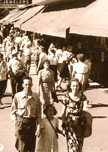|
|---|
last update: October 23rd, 2007
Collapse of the Local GiantsA UTAH STORIES INVESTIGATION: 
A battle won against a lost cause After the small victory axing the skyway proposal. Auerbach's owner, Fred Auerbach saw that the future still looked dismal for his retail store. Auerbach foresaw that with the completion of the Crossroads Mall across the street from the Z.C.M.I Center his business would face even more difficult times than they had had during the beautification projects from the previous years. Fred Auerbach decided to sell his business. In 1977 after being family owned and operated for the past 112 years, the Auerbach empire, that had spanned three generations, would now be out of his hands. By this time Auerbach had also opened stores in Cottonwood and Fashion Place Mall, these stores were doing well. However, business had been eroding from his retail hub in downtown and Broadway for the past 10 years. Now, rather than face the painful demise of the store that was the realized American dream for his family, Auerbach bowed out and enjoyed and early retirement. It turned out Auerbach's predictions were accurate as the store's new ownership realized further hardship for the business. New owner, Arnold Richer, blamed the Z.C.M.I Center and the beautification projects for Auerbach's finally closing their doors forever, after 114 years in downtown Salt Lake City. 1979:Auerbach's closes after 114 years in downtown Salt Lake City . January 27, 1979 Salt Lake Tribune.
Then mayor Ted Wilson said, " I think we need to find some retail destination to replace the volume of business that is being vacated by Auerbach's. If we don't then that area is going to be in serious trouble." Wilson was correct in his assumption. The malls Wilson greatly endorsed from their inception, began to further erode the street and all rattail activity that wasn't in either of the malls.
After the close of Aurbach's, Exchange Place and the Broadway district dominoes began to fall. Starting with Keith Warshaw, a vertical store with six levels of departments and only one location.
After reading these articles a question remains: Why didn't the Merchants Association fight with greater rigor against the Construction of the Crossroads Mall? Why didn't they apply the same argument they were using to axe the sky bridge plans instead to the entire Crossroads project? Because Auerbachs, Paris Company and Warshaws now had to compete with four of the most successful national departments stores, including J.C Pennies (which was also on Broadway) Nordstrom and Weinstocks the South-end of Main Street would dominate all retail activity. Thanks to beautification, local merchants were now left with, fewer parking places, no overhanging signs and giant wide empty sidewalks. With or without a sky bridge they lost because because of the decisions City Leaders had made in efforts to revive downtown. The most obvious answer to this question is that the Merchants didn't fight this battle because they were already preoccupied in battling City Planners over the Exchange Place "beautification project." Because of this distraction, the mall plans seemed to have passed by without much contention.
1979:Exchange Place Beautification To Hurt Trade? June 25, 1979 Salt Lake Tribune.
While many of the South-end retailers are going out of business due to the "beautification" project, people are getting their first look at the new Crossroads Mall. May 22, 1980: Deseret News.
As the Crossroads Mall was nearly completed every photograph found in the state archives is taken of a small portion of the Southern side of the mall where they have reinserted the previous beautiful sandstone work of the Amussen Pioneer building into the cinder block fortress of the new mall. "skillfully integrated into the mall's exterior." the article said. Another casualty of the new Crossroads mall was the former Richard's Street. The new mall will pay homage to the former Pioneer street by naming the food court, where McDonalds hamburgers are sold, after the historic marketplace. Utah Woolen Mills Owner Bart Stringham remembers how he and his father fought against the building of the Crossroads Mall. "but they didn't want to listen to us.. Now they are tarring down the mall to try and bring back some of what has been lost," says Stringham. Utah Woolen Mills moved their business into a new building owned by Zion Securities just West of the Crossroads Mall. Utah Woolen Mills is the only local business that survived from Richard's Street. They remain in this same building today and are open throughout the duration of the new City Creek Center development project. 1980:S.L mall opens doors to shoppers-- August 8th, 1980 Deseret News
With the completion of the Crossroads Mall across the street from the Z.C.M.I center, the retail mall era had become realized in the heart of downtown Salt Lake City. With fanfare and excitement all the important Utah dignitaries were at the ribbon cutting ceremony, including Governor Scott Matheson, L.D.S Prophet Ezra Taft Benson, Mayor Ted Wilson and Mickey Mouse. The project provided an additional 2.1 million square feet of retail space to downtown at the amazingly low cost of just $100 million. Shoppers were once again, going to downtown to shop. And with ample parking and two malls on one city block there were hundreds of new national retail destinations available including Nordstrom and Weinstocks. However, was there a price paid for this development unforeseen by the City leaders at the time?
|